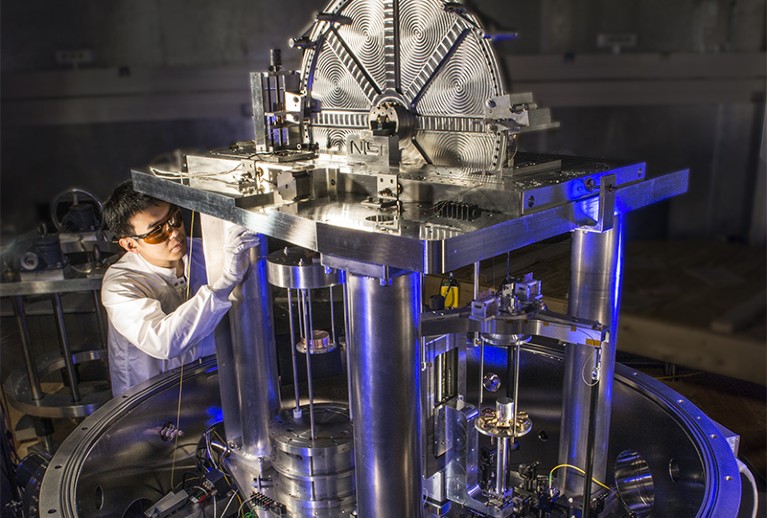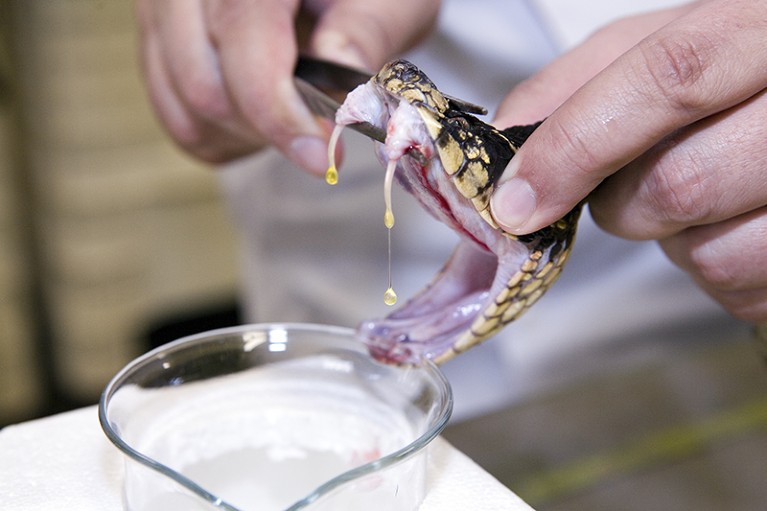EVENTS
New definitions of SI units come into force Revised definitions of four scientific units — the kilogram, the kelvin, the ampere and the mole — came into force on 20 May, World Metrology Day. All the base units of the International System of Units (SI) are now defined according to fundamental constants of nature, rather than arbitrary references. The shift marks the biggest shake-up of SI units since 1875, and will be most transformational for the kilogram. Until the redefinition, all masses were calibrated against a lump of platinum and iridium kept in France. Now, the kilogram will be derived through experiments using Planck’s constant. One method uses a device called a Kibble balance. The ampere, the kelvin and the mole are redefined using other experiments. The three other basic SI units — the second, the metre and the candela — are already based on constants.

The US National Institute of Standards and Technology’s Kibble balance.Credit: Curt Suplee/NIST
Tornado drones Atmospheric scientists will soon get an unprecedented view of the conditions that trigger some of the United States’ most devastating tornadoes. A US$2.4-million project called TORUS that started on 15 May will send a fleet of up to four drones into ‘supercell’ thunderstorms to gather data on the atmosphere. These rotating storms pummel the central United States with lightning, hail and strong winds every spring and summer, and some develop into tornadoes. Scientists hope that the resulting information will help them to more accurately forecast which supercells will generate tornadoes. Current tornado-warning systems have a high false-positive rate, say researchers with TORUS, which is short for Targeted Observation by Radars and Unmanned aircraft systems of Supercells.
POLICY
Fake-news law Singapore’s parliament has passed a law that bans the spreading of “a false statement of fact” that harms the public interest — raising concerns among academics. The bill, passed on 8 May, allows Singapore’s ministers to order social-media and messaging platforms to remove material deemed false by authorities, or force sites to run corrections. Penalties include up to ten years in jail for individuals, and fines for companies. In April, 125 academics sent a letter to the city-state’s education ministry raising concerns that scholarly discourse could be stifled. The letter noted that much academic work focuses on disputing apparently established ‘facts’, and that even quantitative research deals in probabilities, not absolute certainties. Education minister Ong Ye Kung later dismissed the concerns, saying that natural-sciences research based on real data would not be deemed false. “Hypotheses, theories, and opinions” in the humanities would also be exempt, he said.
CRISPR-baby rules China is poised to introduce protections for human genes and embryos in the country’s new civil code. In a draft of the code, both are listed in a section on ‘personality rights’ that should be protected. Experiments on genes in adults or embryos that endanger human health or violate ethical norms can accordingly be seen as a violation of a person’s fundamental rights. Lawyers say the regulation would mean that anyone who manipulates genes in humans is responsible for any health consequences. “The law makes clear that those who do research with human genes and embryos cannot endanger human health or violate ethics,” says Zhang Peng, a criminal-law scholar at Beijing Wuzi University. China has been revising its civil code — the overarching legal framework that governs non-criminal disputes — since 2002. The latest draft was submitted last month to the country’s chief legislative body, the Standing Committee of the National People’s Congress, and is likely to be adopted next March. The new protections for human genes and embryos was prompted by uproar over controversial gene-editing experiments done last November by Chinese biophysicist He Jiankui. He claimed to have carried out experiments on human embryos that resulted in twin girls whose DNA had been edited to make them less susceptible to contracting HIV.
CLIMATE CHANGE
Australian election A coalition between two centre-right parties will continue to govern Australia — an unexpected outcome of the country’s 18 March election. Many polls had predicted that the Liberal–National coalition government, led by Scott Morrison, would be ousted by the centre-left Labor Party. But as Nature went to press, the coalition had won 76 seats in the parliament’s lower house, enough to form a majority government. Although the economy, jobs and power prices were the main focus of the election campaign, the environment and climate change also featured prominently. Labor promised to cut greenhouse-gas emissions by 45% of 2005 levels by 2030; to introduce vehicle-emissions standards; and to limit land clearing. The coalition says that it will reduce emissions by 26–28% of 2005 levels by 2030, a cut that Australia committed to under the Paris climate accord. But scientists say this target is not enough to meet the agreement’s goal of limiting global warming to below 2 °C.
HEALTH
Snakebite fight Biomedical-research funder the Wellcome Trust has announced a £80-million (US$103-million) initiative to improve the treatment of snakebites in poor countries. Snakebites are a daily concern in many tropical and sub-tropical regions and kill an estimated 81,000–138,000 people a year, partly because they are treated with archaic, animal-derived antivenoms that often work against only one species. The programme, announced on 16 May, will support the development of antivenoms that can treat toxins of multiple snake species. Techniques used in genomics, immunology and synthetic biology offer hope. Wellcome — together with medical charity Médecins Sans Frontières (also known as Doctors Without Borders) and local partners — plans to establish an African network of clinical trials designed to test promising drug candidates.

The venomous Bothrops jararacussu.Credit: Werner Rudhart/VISUM/eyevine
POLITICS
Brazil protests Crowds gathered in more than 220 Brazilian cities on 15 May to protest against the government’s plan to cut US$1.85 billion in funding for public education. Many of the demonstrators were students and teachers, who say that the funding cuts could have widespread effects on Brazil’s education system, from primary schools to universities. One area that could be especially hard hit is graduate studies in the social sciences, humanities and linguistics — fields that “do not generate enough scientific production”, according to the country’s education minister, Abraham Weintraub. On 16 May, Brazil’s President Jair Bolsonaro said the protesters “don’t know anything. They’re useful idiots, imbeciles.”
COMMUNITY
Diversity scheme The Canadian government will begin a pilot programme on 3 June designed to boost diversity in academic research. The project, named Dimensions, is inspired by Britain’s Athena SWAN scheme, which rates universities and other educational institutes as bronze, silver or gold on the basis of their inclusiveness and equality in hiring, promoting and retaining female staff. The Canadian programme aims to tackle systemic barriers in research culture that are faced by women and other under-represented groups, such as indigenous peoples, people with disabilities and those from minority ethnic groups. It will ask institutions to endorse a charter that outlines eight principles on equality. Science minister Kirsty Duncan launched the initiative alongside Can$5.3 million (US$4 million) in funding to support institutions in their efforts.
TREND WATCH
For the first time, the annual Leiden Ranking — which measures universities’ scientific performance on the basis of bibliometrics — has included a gender-balance metric that calculates the proportion of women among a university’s total number of research-paper authors. The creators looked at the 2014–17 research output of 963 universities, and the overall results support previous work that shows women account for about 30% of authors of academic papers worldwide. Universities in South America and Eastern Europe did best in the gender ranking — the highest was the Medical University of Lublin in Poland with 56% female authors. Many universities in Asia came low in the rankings, and overall, European universities did slightly better than North American ones. Of the world’s leading scientific institutions, the Karolinska Institute in Stockholm ranked 71st with 43% female authors; Harvard University in Cambridge, Massachusetts, ranked 286th with 34%; Imperial College London came 596th with 27%; the Massachusetts Institute of Technology in Cambridge ranked 752nd with 22%; and the Swiss Federal Institute of Technology in Zurich 807th with 19%.

Source: Leiden ranking





